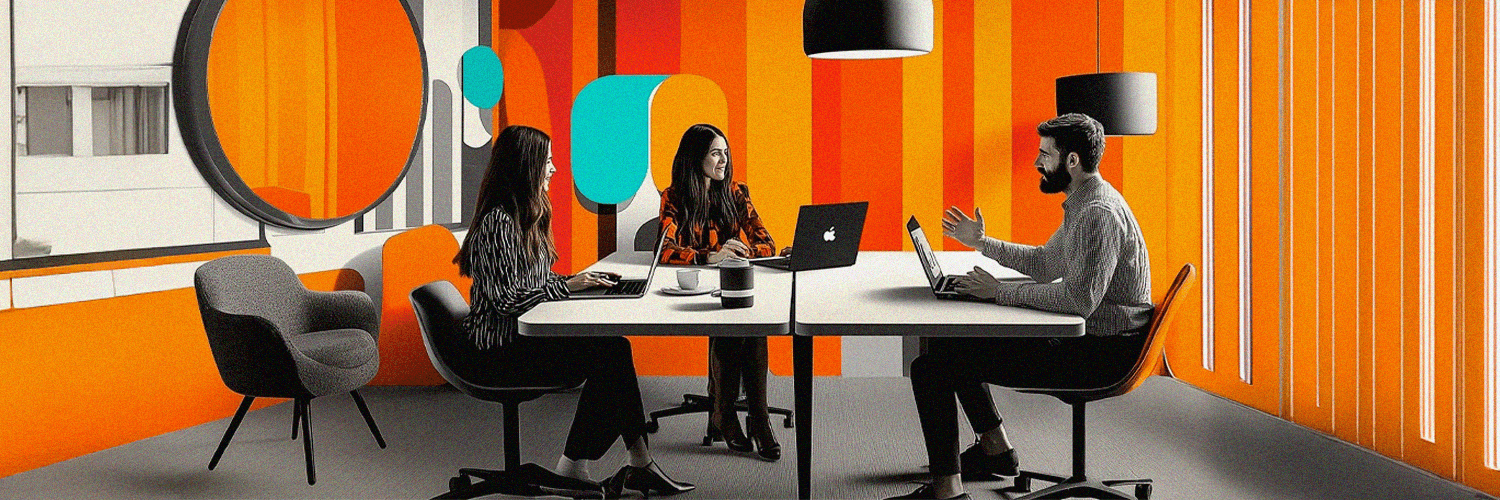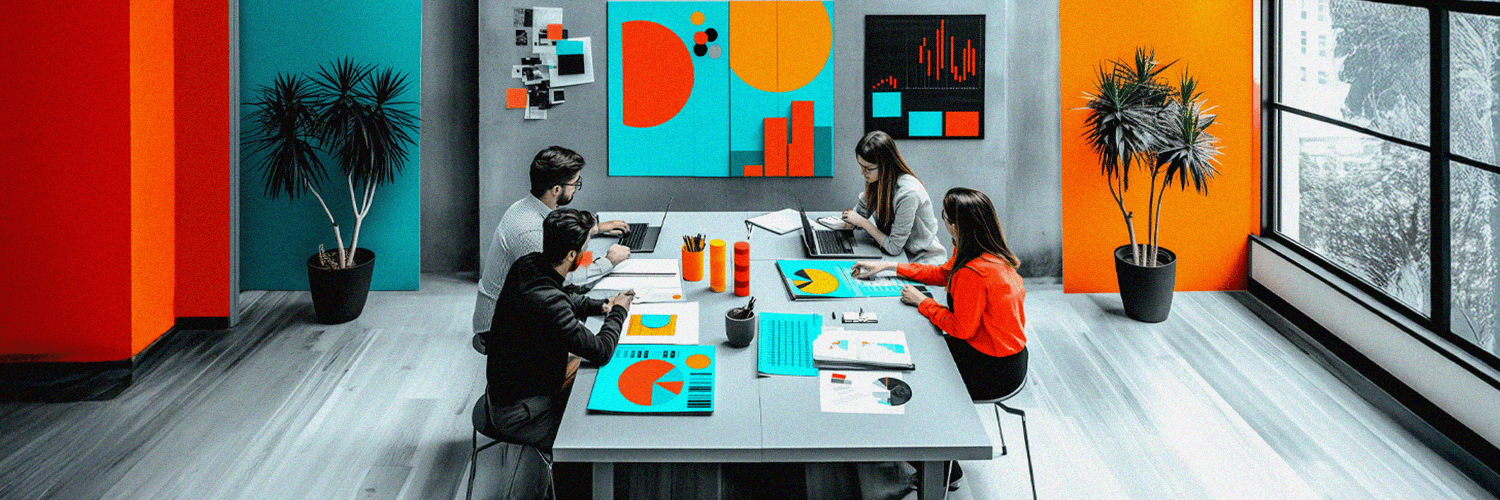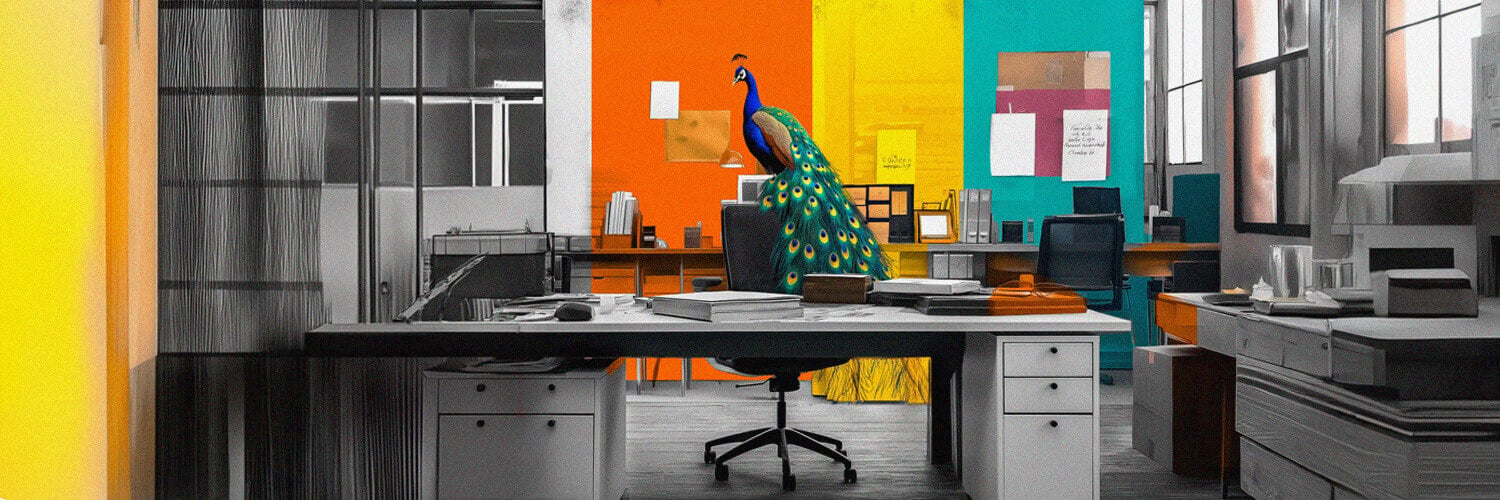96% of the highly engaged and satisfied employees feel there’s a strong culture of teamwork and collaboration in the companies they work for. And that’s what an office collaboration space helps you achieve: to bring your employees together and get them to cooperate.
Which — stats show it — is a strong enough reason for them to feel highly engaged and satisfied with their jobs and your company as a whole.
“Ok, Ok, but how do I create one that naturally brings people together?” you might ask yourself.
In other words: what makes a great collaboration office space?
What are the main pillars to consider for putting together a workspace that’s truly collaborative? And not just a pile of workspaces grouped together.
Let’s get you some answers.
TL;DR:
- Office collaboration spaces promote a positive, free-flowing exchange of ideas and inspiration among employees, and support face-to-face communication, which leads to greater teamwork.
- A truly collaborative office requires a strong foundation, designed with teamwork in mind, equipped with the necessary technological resources, comfortable, accommodating, large enough, and catering to all tastes, needs, and personalities.
- There are four types of office collaboration spaces: meeting and conference rooms, mixed-use spaces, huddle rooms, and collision spaces.
- The benefits of having collaborative spaces in offices include stronger company culture, improved teamwork, and better space utilization.
Office Collaboration Space: The Place for Teamwork and Inspiration
A collaborative workspace is where teams or members of a team come together to run through ideas collectively.
And to get inspired.
For that’s what this positive, free-flowing of ideas or knowledge between employees, does: it feeds their inspiration. It sparks ideas.
And it supports great face-to-face communication. Employees get together physically in a collaborative office, where real-world visual cues — tone, body language, nuance — are much easier to read than in the online world.
This breaks down communication barriers. And since great communication leads to greater teamwork… you can draw the conclusion.

What Makes an Office Collaborative?
For you don’t just clump together several workspaces and that space becomes “collaborative” all of a sudden.
That would only mean bringing individual desks together, nothing more.
For an office to be truly collaborative — to bring workers together naturally — it needs a strong foundation. One made of a few key principles.
In short, the collaborative office should:
- Be designed with teamwork in mind: it should get people involved. And make them feel supported, inspired, and enabled while involved in collaborative work.
- Be equipped with all the needed technological resources: from collaborative platforms like Zoom or Slack, to cloud software, such tools enable employees to engage and work together.
- Be comfortable and accommodating: because people have their best ideas when they feel most comfortable. So think ergonomic chairs, cozy couches, great lighting, and acoustics when designing your collaboration work spaces. They’ll make people feel at ease and more focused.
- Be large enough: give people enough space to spread out while still working in the proximity of their colleagues. A crammed place is the best synonym for “forced collaboration”.
- Cater to all tastes, needs, and personalities: from seating arrangements to the choice of furniture, all the resources in such a collaborative workspace should accommodate the immediate work needs of most (if not all) of the employees sharing that space. Variety is key here.
Types of Office Collaboration Spaces
Talking about meeting a variety of needs and preferences when designing your collaboration workspace, here are 4 types of office collaboration spaces to consider for putting together the perfect “combo”:
Meeting and Conference Rooms
They’re still central spaces in most offices.
Why? Because they allow large numbers of people to meet in a private space. And they’re usually equipped with all the right technology needed for productive work sessions.
Add comfort to the equation and you get a meeting space where teams can do their best focused work together.
Mixed-Use Spaces
As the name says, they are mixed-personality/mixed-scale collaborative spaces in offices with furniture of different styles that encourage employees to approach their work from a more creative angle.
With different clusters at hand to choose from — living room-like furniture, workshop-style spaces — and put together, employees are free to adapt their collaborative space according to their changing work needs.
Huddle Rooms
They’re small spaces with flexible seating options, screens, and whiteboards, great for individual work or small group brainstorming sessions.
For quiet, focused work that sometimes can’t be done in larger spaces, accommodating large groups of employees.
Collision Spaces
They’re collaboration areas in your office where people can socialize over a cup of coffee or a quick snack.
Take them as places where your employees can relax while connecting with their colleagues whenever they feel like it.
Tip! To spark creativity during these short socialization sessions, you’ll want to create a distinct experience. So, consider a different design from the rest of the workplace for these collision spaces.

What Are the Benefits of Office Collaboration Spaces?
The most obvious ones are better communication, increased efficiency, and productivity.
But the benefits of having teams engaged in collaborative work, in collaborative workplaces, are not just purely work benefits.
When interaction becomes ingrained in the work itself, the company culture benefits, too. With teammates interacting on a regular basis, at work, getting closer, a tight-knit company culture is taking shape.
Now, let’s put the spotlight on some of the key benefits of having collaborative spaces in offices.
Stronger Company Culture
Not at all surprising, if you come to think of it. The office environment reflects your company’s culture.
If the environment in your workplace is one where collaboration and regular interaction between your employees are the norm, these are also the traits engraved in your company culture.
And a collaborative company culture will always be a stronger one compared to one praising purely individual success and individual efforts and endeavors.
Improved Teamwork
It takes a team to put together multiple great ideas into THAT great final idea. And to actually execute it.
This is precisely what a great office collaboration space helps you achieve:
Get teams to work together so that each member’s individual efforts contribute to the company’s success.
Better Space Utilization
A well-thought-through, well-designed collaboration office helps you make the most of your workspace.
Say you’re a rising start-up with a low number of employees: a collaborative space, which accommodates your whole team, would be much more effective for you than renting a full-floor office, don’t you agree?
Cost Savings
Obviously, better space utilization leads to cost savings, as you’ll only pay for what you need.
And you’d maybe even share utility costs with other companies using the same collaborative workspace.
Do your hybrid or remote workers need a private office to do collaborative work in? Provide them with a workplace that accommodates them all, where they can get together and work together when they need to.
And only pay for the services you do need.
Sustainability
A benefit resulting from the very sharing of the office collaboration space with other companies. Or from simply renting an office instead of the entire floor.
The use of resources from electricity to water to gas is automatically lower and therefore more… sustainable.
Higher Productivity
With team members working on projects in the same office collaboration space, in person, not only that ideas get shared more easily, but you take siloing key tasks out of the picture.
And all those “blockers” that might put a project on hold, where employees waste time trying to track down their missing colleagues.
Moreover, in a collaborative space with open floor plans and (in most cases) glass partitions, people still can engage in deep work and get to work side-by-side with very little distraction.
More Flexibility
A collaboration office space breaks the rigid frame of the traditional office, resulting in more flexibility.
Team members get to choose their way of working and configure their own workspace within the larger, commonly shared office space. And this level of flexibility translates into a more creative approach to work.
And boosted productivity.
Does Collaborative Office Space Work for Everyone?
Now that we’ve gone over the benefits, you might be already sold: a collaborative office space should be your team’s place of work.
And yet, before you jump on the trend, there are some key aspects you'll want to think through first:
Your team/s ways of working: is your company one of those which, after COVID-19, have started to use their office spaces for work AND for employee interaction? Then a collaborative workspace suits you 100%.
Your company culture: if teamwork and cooperation are not important components of your company culture, if you’re not the creative type of business, but rather a more professional, corporate-like one, forcing a collaborative approach in the workplace might not be the best option for you.
Your budget: when you need to keep a close eye on your expenses, the flexibility of a collaborative workplace becomes particularly tempting. Having multiple collaborative spaces in your office allows you to scale up or down depending on your immediate work needs: create more such spaces in your office or cut them down to a convenient minimum if most of your employees work from home.

So, What Makes a Great Office Collaboration Space?
And we’re back to your valid question from the beginning of this post:
“Ok, Ok, but how do I create one that naturally brings people together?”
For that’s what a great office collaboration space is: a place that drives employees to seek interaction and collaborative work… naturally.
Here’s what your list of essentials should include when you consider putting together such a collaborative space:
Multiple Types of Working Areas
You’ll want your office to incorporate several types of collaborative working areas.
From areas that support working collaboratively within a large team, like conference rooms, to huddles, great for brainstorming and private catch-ups of smaller groups,
In short, make sure your office meets as many employee needs and working styles as possible.
Amenities for Productivity
It goes without saying that a great office collaboration space has all the needed amenities to ensure focused work and your employees’ boosted productivity.
From ergonomic chairs to good-quality office desks, soundproof rooms for video calls, and whiteboards, make sure you design a collaborative work environment equipped for productivity.
And yes, a great view should be on your list, too.
Employee Wellbeing-Centered Design
Integrate well being concepts into the design of your collaborative office for happier, more engaged employees.
How? Here are some simple, yet effective steps you can start implementing today:
Give people control over their workspace: give them easy access to the policy tools, technology, furnishings, and workplace design that grant them choice over the workspace (e.g. flexible task lighting and adjustable height office desks, individual and group workspaces). And over the work process itself.
Bring nature into the workspace: from plants to outside views accessible from most workspaces, to designs made of natural materials, make sure your collaborative workspace meets that biological need your employees have to connect with nature both physically and mentally. It’ll improve their wellbeing and reflect on their productivity.
Integrate natural light: so simple and yet such an effective step you can take, with a powerful impact on your employees’ minds and bodies. Make sure workstations in the office collaboration space get enough natural light.
Keep noise distractions to a minimum: offer both informal socialization spaces and quiet, phone-free areas.
Make physical health a top priority when designing your collaborative working space: give employees the choice to stand or sit when working, to move from one position to another. And integrate ergonomic principles in all the elements of design.
Zero Constraints
The key objective of this office space is to provide a collaborative, productive, truly non-constraints office-like environment to the employees using it.
It’s the perfect context for the thinking process to flourish and grow into innovation, and become…. infectious.
Biophilic Design
A great office collaboration space has nature incorporated into it. It makes the most of its health and wellbeing benefits for the people working and interacting in that space.
And don’t think of something overly complex or costly.
Things like abundant natural lightning, pieces of furniture in soothing shades of green, natural wood flooring, and indoor plants are all obvious and easy-to-underestimate components of a biophilic design that you can easily include in your collaborative work space(s).
Technology in Collaborative Workspaces
The bedrock of any modern workspace today rests on technology. Its application to collaborative spaces has become crucial for businesses striving for productivity and efficiency.
Workplace management technology, like visitor management and office space bookings all in one, easy-to-access, easy-to-use platform (such as YAROOMS), make the difference between an office collaboration space and a… great one.
They smooth down the “wrinkles” of sharing the same workspaces with other employees, other teams.
Make sure to integrate modern workplace technology into your office collaboration space to boost your employees’ productivity, support flexibility, streamline their communication and enhance their collaboration.
Role of Technology in Enhancing Collaboration
Technology influences our collaborative efforts profoundly by extending our capabilities beyond physical limitations to define collaborative outcomes.
Innovative tech tools enable employees working from different locations to stay connected, collaborating synchronously or asynchronously as required. Breaking down geographical barriers has indeed amplified the idea of the cooperative workspace.
Cloud-based platforms allow team members to share files instantly, while project management software keeps everyone on the same page regarding project progress.
Virtual meeting rooms powered by video conferencing technologies make discussions immersive even when miles apart. So, technology plays an inherent role in boosting connectivity, accessibility, and collaboration.
Integrating Technology Seamlessly into the Workspace
Proper technology integration into shared working spaces can be game-changing at its core. An indispensable part is making sure devices like computers, printers, or projectors are accessible without adding clutter.
Technological infrastructure should ideally involve high-speed internet connection for seamless communication and robust data storage systems that provide swift access to required resources. Balancing aesthetics with functionality can create a comfortable environment conducive to creative thinking and problem-solving.
Smart office technologies that control lighting or air-conditioning based on occupancy levels add another layer to creating an optimal workspace. Touchpoints for integrating technology should be user-friendly, sustainable, and practical without compromising comfort or productivity.
Challenges and Potential Solutions in Collaborative Workspaces
With the progressive acceptance of collaborative workspaces, a fresh set of challenges has also surfaced. Identifying these hurdles early on is crucial so they can be converted into stepping stones for greater productivity.
Overcoming Barriers to Collaboration
Collaboration doesn't merely mean working together in the same area; it signifies shared goals and unified operation.
A prevalent barrier is different work styles from diverse backgrounds. Some may prefer isolated sanctuaries, while others might fancy vigorous discussion areas.
Conflicting preferences can generate friction within shared working spaces. To conquer such an issue:
- Alias flexibility as your key mantra- integrated designs accommodating privacy and sharing should be adopted.
- Continuous learning programs can promote understanding between collaborators.
- Foster an environment where employees relish blending various work methods for creative output.
Engage in defined collaboration workshops or initiatives where all opinions are respected, and practical strategies are based on mutual consensus.
Managing Distractions and Maintaining Focus
Maintaining focus in vibrant surroundings can get troublesome at times - chatter from colleagues or even white-collar noise may become disruptive elements in a cooperative workspace.
Some effective fixes include:
- Establishing 'quiet zones' across the workspace dedicated solely to focused tasks.
- Using noise-cancelling headphones to filter out unwanted sound-bites
- Installing acoustic panels to minimize sound reverberations.
Remember, monotony shouldn't seep under the guise of dampened noise levels; maintaining balanced energy throughout is pivotal for healthy functioning!
Mitigating Privacy Concerns In Shared Spaces
Compromised confidentiality forms another knot in this array of problems concerning collaboration office space settings.
Virtual meetings display snippets of our personal lives without consent, which some might fear violating their privacy perimeter.
Possible remediations involve:
- Procuring individual storage lockers where employees' belongings are safely stowed.
- Encouraging tailored workspace ideas to allow personalization yet ensure security.
- Incorporating technology with stringent privacy measures to allay fears of data theft in virtual collaborative areas.
Privacy concerns should be dealt with proactively, instilling trust in employees about the respective space's sanctity.
By doing so, the apprehensions around cooperative workspaces would noticeably ease out, leading to an atmosphere of productivity and positivity. The willingness to adapt and evolve will lead us to unprecedented success within collaborative workspaces.
Strategies to Foster Collaboration in the Office Space
Encouraging Open Communication and Knowledge Sharing
A fundamental cornerstone for building collaborative working spaces is cultivating an atmosphere marked by open communication and free-flowing knowledge sharing.
Companies thriving on collaboration encourage employees to freely express opinions, share insights, or brainstorm ideas without fear of censure or judgment.
This free exchange gives everyone a voice and allows unique solutions to arise from unconventional perspectives.
Departmental Collaboration
Often, companies find themselves operating in silos where each department works independently. Breaking down these walls within the organization is crucial for collaborative office design.
Cross-functional teams allow employees to experience diverse problem-solving methods across multiple disciplines - helping them learn about other departments while broadening their skill sets.
Activities and Events
Organizing structured activities and events to foster teamwork could also boost camaraderie among colleagues.
Team projects leveraging different employees' skills will result in efficient output and pave the way for building stronger inter-employee relationships.
Simultaneously, hosting networking events like luncheons or group outings can help staff get more acquainted on a personal level, thereby strengthening professional ties.
Tools And Resources For Effective Collaboration
In our technologically-driven age wherein digital nomads reign supreme among other working styles, providing fitting tools such as cloud-based software solutions escalates team synergy exponentially regardless of physical location constraints.
Creating A Supportive And Inclusive Work Environment
Lastly, an inclusive work environment forms the bedrock for a proper collaboration office space.
This involves valuing diversity - embracing viewpoints from various ethnic backgrounds, ages, and genders to create a supportive and engaging workplace. Such environments breed creativity, innovation, and productivity as employees feel acknowledged and valued, boosting their morale and motivation.
The consequence is better individual performance, leading ultimately to organizational success.

Tips for Managing a Collaborative Office Space Effectively
Collaborative office space can lead to improved productivity and engagement among employees. However, this form of workspace demands effective management strategies.
Here are some valuable tips that could enhance the efficiency and performance of your team in a collaborative environment.
Regular Performance Evaluations and Feedback Sessions
For any organization to meet its desired goals within a collaborative workspace, it is vital to conduct regular performance evaluations. These check-in sessions allow the employee and manager to assess what's working well and where improvements may be needed.
- Conducting weekly or monthly meetings can help keep track of individual progress as well as collective targets.
- Offering constructive feedback allows employees to identify their strengths and shortcomings. It fosters continuous growth by spotting weak areas, thereby encouraging skill enhancement.
- Acknowledging achievements, rewarding contributions, and addressing underperformance motivates individuals while enhancing overall morale in the office collaboration space.
The success of collaborative workspaces hinges on these evaluations, which foster transparency, trust, accountability, and above all else—progress.
Facilitating Ongoing Training and Development Opportunities
Facilitating ongoing training programs is crucial to get the most out of your team within a collaborative office design.
Such initiatives open up endless opportunities for improvement while encouraging team members to learn, grow, and adapt constantly.
- Investments in professional development breed innovation by helping employees stay updated with industry trends.
- Regular workshops or webinars prompt employees to acquire new tools or knowledge that could boost their efficiency in carrying out tasks.
- Encouraging peer learning within the office collaboration space significantly improves skill sets while fostering stronger bonds between employees.
Nurturing an environment that values training enhances competency and instills confidence among workers operating within a collaborative office space.
Functional Projects and Collaborations
Creating functional projects is instrumental for teams working together within collaborative work spaces. Joint undertakings provide an unmatched opportunity to unite diverse skills and experiences.
- Cross-functional collaborations can take the form of brainstorming sessions or formal project integrations. Such efforts break down silos, stimulate creativity, and foster collective problem-solving.
- Include team-building activities that focus on improving collaboration and enhancing overall team performance.
- Regularly reviewing project timelines within your office collaborative space keeps projects on track and ensures shared understanding among all members involved.
Fundamentally, functional partnerships in a collaborative workspace revolutionize the traditional operating modes—cultivating empathy, adaptability, and forward-thinking individuals.
Maintaining Open Channels of Communication and Addressing Conflicts Swiftly
Communication must be given utmost importance to manage a collaborative working space effectively. Open channels encourage transparency—a prime element to mitigate conflict in collaborating teams.
- Encourage employees to voice opinions or share ideas without hesitation. This elicits a sense of security while promoting inclusivity within workplace dynamics.
- Fast resolution of issues is invaluable in any workspace scenario. A straightforward process for airing grievances should be established that safeguards interests without interrupting workflow.
- Ensuring regular briefs about changes or updates prevents misunderstandings while establishing cohesiveness throughout the organization.
Fostering open dialogue strengthens bonds within cooperative spaces while enabling swift problem-solving—ultimately driving productivity in this evolving era of workspaces.
The Future of Collaborative Workspaces
As we gaze into the horizon and ponder upon the future of work, a significant paradigm shift becomes evident. Between technological improvements and evolving employee preferences, the concept of a traditional office is quickly transforming into that of collaborative workspaces.
Trends Shaping the Future of Collaboration in the Workplace
Future workplace trends indicate a defining tilt towards more flexible structures. Instead of being tied to specific desks or offices, employees are gradually moving towards shared working spaces where they can connect with others on their terms yet remain productive.
- Embracing Hybrid Models: Companies increasingly resort to hybrid work models whereby employees split their time between working from home and utilizing collaboration office space at company premises. This format offers a valuable balance between solitary focus-driven work and collaborative activities.
- Prioritizing Employee Well-being: Recently, mental health has taken center stage when considering workspace ideas. A well-designed cooperative workspace caters to professional needs, promotes physical activity (like stand-to-work stations), and includes areas dedicated to relaxation during break times.
- Sustainability: Amid growing concerns about environmental degradation, businesses committed to sustainability will ensure their collaborative areas comply with 'green' principles, employing energy-efficient technologies and using materials with minimal ecological footprint.
- Digital Nomadism: As remote working becomes more prevalent, so does digital nomadism - people choosing to travel while maintaining employment by relying heavily on technology.
As companies define collaborative spaces as a fusion of flexibility, well-being, environmental consciousness, and connectivity facilitated by advancements in technology, it is clear that such workspaces will be instrumental in shaping the future fabric of organizations globally.
Innovations and Advancements in Collaborative Technologies
Innovations suited for collaborative spaces enhance communication among teammates regardless of location – an essential asset owing to shifts brought about by distributed teams across geographies.
- VR & AR Applications: These allow employees to experience a mutual workspace virtually, facilitating real-time engagement and interaction.
- Cloud-based Collaboration Tools: Software as a Service (SaaS) enables multiple users to work on shared documents in real-time. Consequently, rapid information sharing minimizes potential confusion due to version control or synchronization issues.
- AI-enabled Digital Assistants: These lighten the burden of mundane administrative tasks from meeting scheduling and note-taking to detailed activity reports, allowing for more focused cognitive efforts on creative and innovative tasks.
- IoT in the Workplace: From adjusting room temperatures to booking conference rooms, IoT is set to revolutionize the automation of everyday office tasks, making collaborative spaces more efficient.
As technology advances at an unprecedented pace, one thing remains conditional – ensuring these innovations are seamlessly integrated into collaborative workspaces without becoming overly intrusive or complex, sustaining user comfort and productivity.
The future seems promising and full of opportunities for collaborative working dynamics, with technology playing a catalytic role in easing the shift.
%20(16).png)











